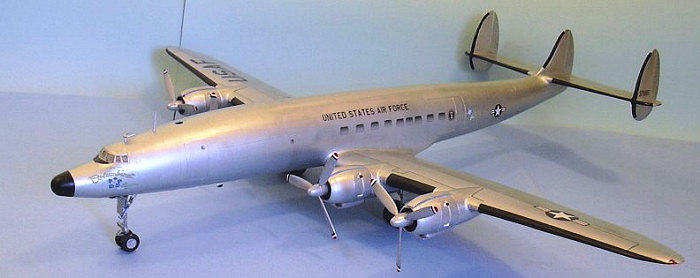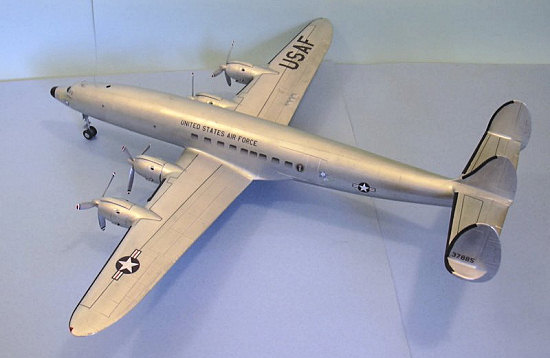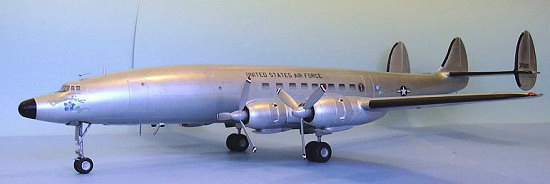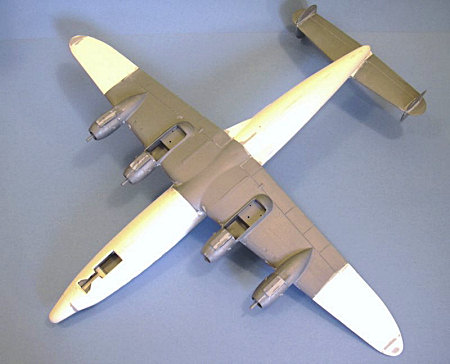
Heller 1/72 Super Constellation
| KIT #: | ? |
| PRICE: | $34.95 MSRP |
| DECALS: | Two options |
| REVIEWER: | Tom Cleaver |
| NOTES: | Airfix boxing |

| HISTORY |
Without a doubt, the Lockheed Constellation is the best-looking multi-engine piston-powered airplane ever built. There isn’t a straight line in the design other than the leading edges of the flying surfaces. The fuselage is a series of compound curves that have never been surpassed for aesthetic beauty, even if the truth is that the interior is much less “passenger friendly” than the “aluminum time tubes” created by Douglas and Boeing.
Designed in 1937 in response to a request by Howard Hughes for a 40-passenger
airliner with a trans-Atlantic range and a speed above 300 mph, the
Constellation revolutionized airliner design when it appeared in 1942. Hughes
himself flew the  prototype on a record-setting transcontinental flight that
clearly demonstrated what postwar commercial air travel was going to be like.
prototype on a record-setting transcontinental flight that
clearly demonstrated what postwar commercial air travel was going to be like.
By
1949, Lockheed saw that the airframe was capable of an increase in useful load.
In order to speed development, the first Constellation was purchased from Howard
Hughes in May 1950 for $100,000 and modified as the Super Constellation
prototype, with the fuselage stretched eighteen feet by inserting constant
diameter fuselage plugs fore and aft of the wing. The prototype was still
powered by the Pratt and Whitney R2800 engines installed in 1945 when it made
its first flight on October 13, 1950. After 22 hours of flight testing, R3350
engines were installed, while the vertical stabilizers were enlarged by eighteen
inches to provide directional stability.
The first production L-1049 flew July 14, 1951. The Super Constellation
incorporated over 550 design changes over the L-049 and L-749 versions. The
third production aircraft, N6203C, entered service with Eastern Airlines
December 17, 1951, the 48th anniversary of powered flight. Until
1953, all turbo-compound R-3350s were earmarked for military use; thus the
L-1049 flew with 2,700 hp CA1 engines, and was quite underpowered.
 Between 1951 and 1958, 579 Super Constellations were built. 259 were flown
commercially, while 320 went to the USAF and USN. The Navy was the largest
operator of Super Constellations with a total of 204 transport and early warning
radar aircraft. The Air Force early-warning aircraft were used operationally
until at least 1977, when the last USAF Reserve squadron was retired at
McClellan AFB in Sacramento, California.
Between 1951 and 1958, 579 Super Constellations were built. 259 were flown
commercially, while 320 went to the USAF and USN. The Navy was the largest
operator of Super Constellations with a total of 204 transport and early warning
radar aircraft. The Air Force early-warning aircraft were used operationally
until at least 1977, when the last USAF Reserve squadron was retired at
McClellan AFB in Sacramento, California.
My Connection With “Columbine III”
While he was NATO Commander, General Eisenhower flew a C-121A (L-749) named Columbine. This was replaced in 1952 by a C-121B (L-1049) named “Columbine II.” After becoming President, Columbine III became Air Force One, and was used by both Presidents Eisenhower and Kennedy until the fall of 1961 when the airplane was replaced by a Boeing 707.
In 1958, I had the rare opportunity to meet a United States President, cement my permanent antipathy for a popular athletic pastime, and fall in love with the Constellation when I met “Columbine III.”
The athletic pastime was golf. My mother had convinced her doctor to get me a job as a caddy at the Cherry Hills Country Club, the premiere golf course in greater Denver, Colorado. To this day, I have never “gotten” the game or the players.
At the time, Denver was “The Western White House due to the fact that President Eisenhower’s wife, Mamie Doud Eisenhower, came from a family who were among the original founders of Denver. Over hie eight years in office, President Eisenhower was a regular visitor at the Cherry Hills Country Club. Various caddies would be chosen to work for the presidential party. In the late summer, after I had been there awhile and demonstrated I could carry the clubs without collapsing and knew to stay silent while the golfers were teeing off, I was for some reason chosen to be among the caddies for the President’s second visit that summer.
Eisenhower had a public image as a “duffer” when it came to golf, but I have to
say that my observation was that the man who
 successfully invaded Occupied
Europe approached the game with the same level of seriousness he brought to
winning the Battle of Normandy. He wasn’t a “scratch” golfer, but those
competing with him had to be on their toes. The Secret Service agent I was
assigned to in the foursome that followed the Presidential Foursome (there was
another Secret Service foursome ahead) really was a scratch golfer, which may
have had something to do with his being on the detail. I might not have known
much about the game, but it’s not hard to spot someone who is Damn Good.
Especially when The Boss banters with him about how good he is.
successfully invaded Occupied
Europe approached the game with the same level of seriousness he brought to
winning the Battle of Normandy. He wasn’t a “scratch” golfer, but those
competing with him had to be on their toes. The Secret Service agent I was
assigned to in the foursome that followed the Presidential Foursome (there was
another Secret Service foursome ahead) really was a scratch golfer, which may
have had something to do with his being on the detail. I might not have known
much about the game, but it’s not hard to spot someone who is Damn Good.
Especially when The Boss banters with him about how good he is.
At the end of 18 holes, President Eisenhower came around and shook our hands, and tipped each of us with a crisp new $5 bill, a veritable fortune to a 14 year old in those days. I’d like to say I had enough knowledge of history to know to save that bill, but no - it was spent quickly the next day at Bonnie Brae Hobbies and Phil Moskowitz got the whole thing.
We got something else that day: an invitation to see the President’s airplane. Being the only serious Airplane Person among the caddies, I thought this was far superior to the monetary tip, and my dad and I went out to Lowry AFB that Saturday following, for the tour of “Columbine III.”
 That was the first time I ever saw a Constellation in person, and I date my love
affair with this beautiful, sexy, airplane to that moment I first saw its
glittering silver shape in the early morning high desert sunlight.
That was the first time I ever saw a Constellation in person, and I date my love
affair with this beautiful, sexy, airplane to that moment I first saw its
glittering silver shape in the early morning high desert sunlight.
We were allowed to go inside the forward cabin, which was where the White House Press Corps and other lower ranking folks rode. It was still pretty fancy to me, but I wondered how much more grand was what would be found on the other side of the locked door just ahead of the wing.
We went back outside in time to see the Presidential limousine pull up. President and Mrs. Eisenhower and his top aides quickly entered the rear door and the airplane soon started up - the first time I heard four big radials in action. When it took off, it banked out of the pattern and caught the sunlight, which flashed over the polished airframe and left a memorable impression on this aeronut. It’s hard to remember a time in America where both Republicans and Democrats were republicans and the presidential barge wasn’t imperial property, but rather something even a citizen could inspect close up.
| THE KIT |
 The
Heller Constellations first appeared in the mid-late 1970s, with the Super
Constellation kit appearing in both a civil version that has been released over
the years in the livery of different airlines, and in its early warning radar
picket version in both USAF and USN markings.
The
Heller Constellations first appeared in the mid-late 1970s, with the Super
Constellation kit appearing in both a civil version that has been released over
the years in the livery of different airlines, and in its early warning radar
picket version in both USAF and USN markings.
The kits are typical for their period, with less than precise fit, and less than precise accuracy of parts, as well as raised-line detail.
The particular kit I built this model from is the Airfix release with markings for a QANTAS and an Air Eire Constellation.
Draw Decals provides a number of interesting ALPS-printed decals, and does “Columbine III” as it was originally done in Fine Scale Modeler by Paul Boyer several years ago.
| CONSTRUCTION |
I knew going in that this kit was going to be vastly different from what I would do as a standard airliner. I didn’t worry about internal detail, and assembled the fuselage with a load of fish weights in the nose to insure nose-sitting. I then assembled the wings and tail and attached them. All this was easy, with the fit revealing just how much work lay ahead.
With the basic airframe assembled, the real work now began.
 I
covered over all the windows with cyanoacrylate glue, which I also applied
liberally to all the joints and seams. The model was set aside to allow all
this to cure overnight, and then I hauled out the sanding sticks and the
MicroMesh.
I
covered over all the windows with cyanoacrylate glue, which I also applied
liberally to all the joints and seams. The model was set aside to allow all
this to cure overnight, and then I hauled out the sanding sticks and the
MicroMesh.
The model was sanded down thoroughly with several grades of sanding sticks. Once I had things as smooth as I could get - which included several second applications of C-A to areas of seams and windows and such - I then applied Mr. Surfacer 500 to all these seams and joints. When all that was sanded down, I went over the model with varying grades of MicroMesh pads.
When everything was as smooth as I could get it, I rescribed the panel lines, and then applied a thin coat of Tamiya Flat Aluminum. This revealed that several seams still existed, which were re-attacked with cyanoacrylate and then Mr. Surfacer. I then sanded off all the paint with fine wet ‘n’ dry, then went over the model again with several fine grades of MicroMesh.
Finally, everything was smooth. I attached the landing gear so the airframe would sit clear of any surface while the paint was drying.
| COLORS & MARKINGS |
Painting:
 I
first painted the de-icing boots with Tamiya Semi-Gloss Black and then masked
these off. I then painted the center sections of the wings with Tamiya Flat
Aluminum, which was then masked off.
I
first painted the de-icing boots with Tamiya Semi-Gloss Black and then masked
these off. I then painted the center sections of the wings with Tamiya Flat
Aluminum, which was then masked off.
I gave the model an overall coat of Talon “Platinum,” then masked off various areas and painted these with Talon “Aluminum” and “Dark Aluminum.” When all this was done, I used some cotton rags to apply light coats of SNJ Polishing Powder overall to give a lightly “polished” look. Doing “polished aluminum” in 1/72 scale with “polished aluminum” paint results in a garish toy-like look. What I was going for was the look I could see in several color photos found on the internet of “Columbine III” during her period of Presidential service.
Decals:
The Draw Decals are very thin and need to be handled very carefully. That said, handling with care resulted in them going on without problem. Their semi-gloss finish allowed me to get away without applying any covering varnish.
| FINAL CONSTRUCTION |
I made various antennas from thin plastic sheet and applied them as I saw them in photos of the original airplane. I then attached the wheels and the props.
| CONCLUSIONS |
 This turned into a fun project and a trip down memory lane. Doing a Connie in an
overall single color allows one to see all the beauty of the shape. It also
allows any viewer of the model to see any flaws. I put several days into
getting the overall surface cleaned up, after about an hour or so assembling the
basic airframe. There are some aftermarket sets for this kit to get better
engine nacelles, and if you can find any of the great old Liveries Unlimited
decal sheets for Connies, you can do a very good looking airliner.
This turned into a fun project and a trip down memory lane. Doing a Connie in an
overall single color allows one to see all the beauty of the shape. It also
allows any viewer of the model to see any flaws. I put several days into
getting the overall surface cleaned up, after about an hour or so assembling the
basic airframe. There are some aftermarket sets for this kit to get better
engine nacelles, and if you can find any of the great old Liveries Unlimited
decal sheets for Connies, you can do a very good looking airliner.
February 2008
If you would like your product reviewed fairly and fairly quickly, please contact the editor or see other details in the Note to Contributors.